Interim changes to the guidance on the use of tactile paving surfaces
Published 21 August 2015
Interim changes to the Guidance on the use of Tactile Paving Surfaces
Foreword
We are committed to facilitating local authorities in creating more inclusive door-to-door journeys with accessible street environments, stations and transport interchanges. The consultation is seeking views on a number of interim changes to the Guidance on the use of Tactile Paving Surfaces and forms part of a wider programme of work to update the guidance, which aims to improve the travel experience for people with visual impairments.
This consultation will run for 12 weeks from 21 August to 13 November.
Executive summary
Introduction
1 The Department is committed to updating the Guidance on the use of Tactile Paving Surfaces, which was published in 1998.
2 Our intention to consult on updates to the existing guidance document was mentioned in the 2014 progress report to the accessibility and equality action plan
3 The current guidance is based on research carried out in the 1980s and we now aim to put in place a programme of research to test a number of alternative basic layouts. Our aim is to ensure that tactile paving is easier for people with visual impairments to understand and that it can be applied consistently.
We want it to work better as a navigational tool and warning system for people with visual impairments, while ensuring designs are safer and more comfortable for mobility impaired people.
4 We will also aim for the guidance to be clearer and easier to understand, so that it is applied with consistency across different areas, in sympathy to local aesthetic considerations and in such a way that it can be adequately maintained.
5 A group of people with an interest in tactile paving and its application met at Friends House in Euston London on the 21st of November 2014 to discuss possible changes to the ‘Guidance on the Use of Tactile Paving Surfaces’ (tactile guidance) published by the Department for Transport.
6 The group included street users with visual impairments, street designers, mobility trainers, traffic engineers, researchers and policy makers. Discussion was facilitated using scale tactile models depicting possible tactile paving layouts for the contexts discussed.
7 Three proposed amendments to the tactile guidance were agreed unanimously, along with two additional design requirements for controlled crossings not currently covered in the guidance. The proposals were also considered at an Urban Design London event on 23 February 2015 attended by groups representing disabled people, users of tactile paving, people responsible for designing highway schemes and others responsible for writing policy and guidance.
8 Workshop participants agreed that a comprehensive review of the tactile guidance is required to re-establish consistency in its application, to incorporate situations not covered in the existing guidance, and improve its utility for its intended users.
9 We believe this programme of research will take at least one year. In the meantime a large number of schemes to install tactile paving are being implemented, and we therefore believe there is an urgent need for improvements to a few interim changes to the guidance.
10 During the comprehensive stakeholder engagement that informed this consultation there was already a clear consensus on the changes outlined in this document. It was not felt that research was needed into these areas prior to consultation. Making these interim changes come into effect quickly could bring about a significant improvement to how people design and implement these schemes and would deliver improvements for people with visual impairments.
11 Any Local Transport Note (LTN) issued, as a result of this consultation, setting out interim incremental changes to the existing guidance, will only be the first part of the full update to the guidance. It is likely further research into other areas in the guidance will be undertaken, as appropriate, with a view to publishing a revised guidance document in due course. We will work with Guide Dogs for the Blind Association, Royal National Institute of Blind People (RNIB) and practitioners to agree the requirements for this further work. Prior to the issue of any new guidance we would urge highways authorities to follow the rest of the existing guidance (unless they have a good reason to depart from it) until such time it is formally replaced.
12 It was anticipated that a full review would not be a particularly speedy process with many street schemes designed and built before its conclusion. Bearing this in mind, these amendments are presented as interim changes so that, if approved and set out in a Local Transport Note, they can come into effect quicker.
13 We plan to have three workshops in London, Bristol and Manchester where tactile models of the proposed changes will be available for users to try. These will take place during the course of this consultation and the dates will be confirmed shortly. Please contact Tactile.Paving@dft.gsi.gov.uk if you would like to attend. 14 Once the consultation is completed we will consider the responses and the findings from the workshops before deciding whether or not to publish the changes in a Local Transport Note.
How to respond
15 The consultation period began on 21 August and will run until 13 November 2015. Please ensure that your response reaches us before the closing date. If you would like further copies of this consultation document or if you require the consultation in another format (Braille, audio CD, etc.) please email your request to Tactile.Paving@dft.gsi.gov.uk.
16 Please send consultation responses to the Sustainable Accessible Travel Division at the Department for Transport
17 When responding, please state whether you are responding as an individual or representing the views of an organisation. If responding on behalf of a larger organisation, please make it clear who the organisation represents and, where applicable, how the views of members were assembled.
Freedom of Information
18 Information provided in response to this consultation, including personal information, may be subject to publication or disclosure in accordance with the Freedom of Information Act 2000 (FOIA) or the Environmental Information Regulations 2004.
19 If you want information that you provide to be treated as confidential, please be aware that, under the FOIA, there is a statutory Code of Practice with which public authorities must comply and which deals, amongst other things, with obligations of confidence.
20 In view of this it would be helpful if you could explain to us why you regard the information you have provided as confidential. If we receive a request for disclosure of the information, we will take full account of your explanation, but we cannot give an assurance that confidentiality can be maintained in all circumstances. An automatic confidentiality disclaimer generated by your IT system will not, of itself, be regarded as binding on the Department.
21 The Department will process your personal data in accordance with the Data Protection Act (DPA) and in the majority of circumstances this will mean that your personal data will not be disclosed to third parties.
- Relaxation of the requirement for the back edge of an area of blister paving to be perpendicular to the crossing direction with two options:
- fixed depth
- following the kerb line
5.1 Replaces:
“The back edge (of the section of tactile surface which extends across the dropped kerb) should be at right angles to the direction of crossing (Figure 3 page 29). This may not necessarily be parallel to the kerb.” 1.5.1.2.
5.2 With: The back edge (of a section of tactile surface marking the boundary between the footway and carriageway) should be parallel with the boundary and set back in the direction of crossing by a fixed distance (typically 800 mm or 1200 mm).
This change should not affect the practice of laying the tactile surface so the blisters are aligned parallel to the direction of crossing nor the requirement for the provision of a stem at controlled crossing points 1.5.1.2 (p30).
5.3 Justification: It was acknowledged by workshop participants that the expansive trapezoidal areas of blister surface, created by the strict application of the perpendicular back edge rule at many irregular crossing points, were not providing the accurate orientation information many people with sight impairments need to navigate.
It was felt that the increase in accuracy and specificity that would be provided by a smaller, simpler area of blister surface would justify the loss of the information provided by the perpendicular back edge.
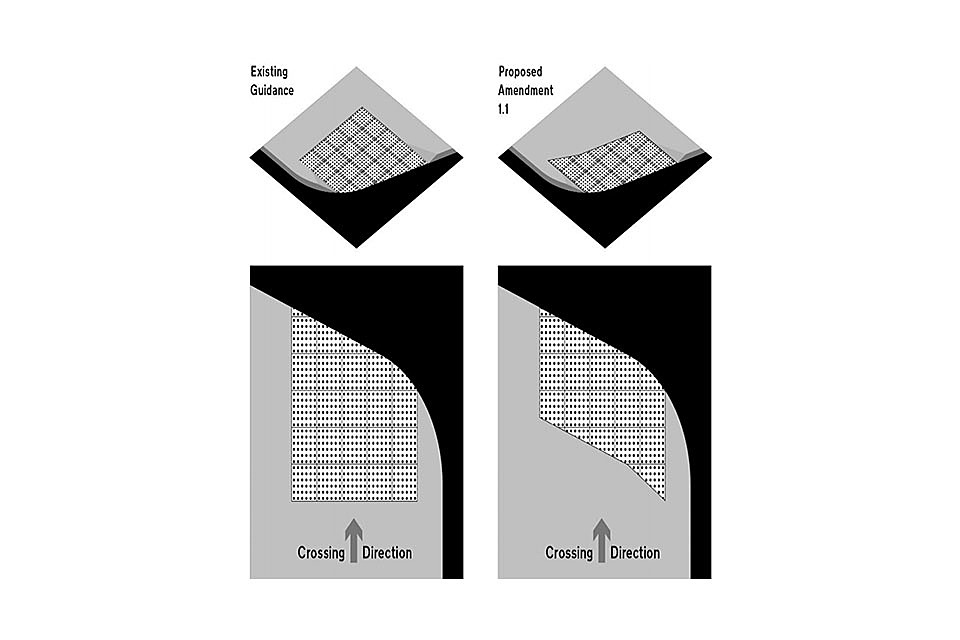
Figure 1.1
Figure 1.1: Treatment of an uncontrolled crossing point at an irregular corner under the existing tactile guidance and under the proposed amendment.
The figure is entitled ‘Existing Guidance’ and shows a trapezoidal area of tactile paving at a curved corner. On the right is a section entitled ‘Proposed Amendment’ showing a band of tactile paving of uniform thickness with the back edge following the contour of the footway and carriageway boundary.
Do you agree with this amendment to the tactile paving guidance?
If you do not agree what are your objections?
(II) Approximation of a fixed depth, with a stepped profile
5.4 Replaces: “The back edge (of the section of tactile surface which extends across the dropped kerb) should be at right angles to the direction of crossing (Figure 3 page 29). This may not necessarily be parallel to the kerb.” [1.5.1.2]
5.5 With: The back edge (of a section of tactile surface marking the boundary between the footway and carriageway) should approximate the line of the boundary using a stepped approach with the appropriate minimum distance (typically 800 mm or 1200 mm) maintained but in some places increasing so that the back edge of each individual tile remains perpendicular to the direction of crossing.
This change should not affect the practice of laying the tactile surface so the blisters are aligned parallel to the direction of crossing nor the requirement for the provision of a stem at controlled crossing points 1.5.1.2 (p30).
5.6 Justification:
It was acknowledged by workshop participants that the expansive trapezoidal areas of blister surface, created by the strict application of the perpendicular back edge rule at many irregular crossing points, were not providing the accurate orientation information many people with sight impairments need to navigate. A stepped approach would reduce the requirement for tactile tiles to be cut to match the kerb profile at the back of the installation (as they already are at the front).
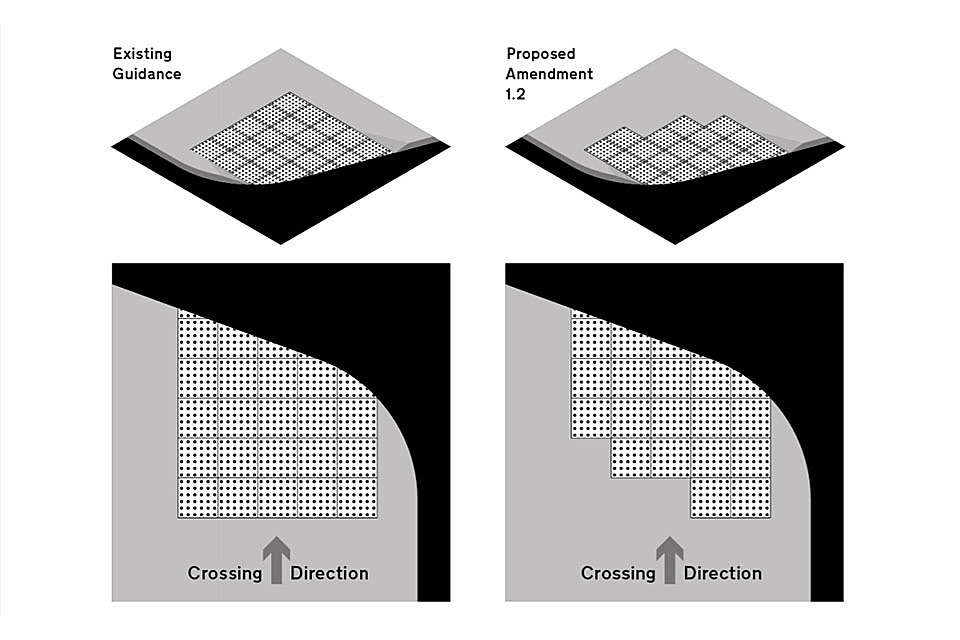
Figure 1.2
Figure 1.2: Treatment of an uncontrolled crossing point at an irregular corner under the existing tactile guidance (left) and under proposed amendment 1.2.
The figure is entitled ‘Existing Guidance’ and shows a trapezoidal area of tactile paving at a curved corner. On the right is a section entitled ‘Proposed Amendment 1.2’ showing a band of tactile paving with a stepped back edge varying in depth between 1200mm and 1800mm.
Do you agree with this amendment to the tactile paving guidance?
Do you agree with this amendment to the tactile paving guidance?
If you do not agree what are your objections?
- Replacement of the requirement for blister paving at a controlled crossing to be red with a requirement for at least a 50% contrast ratio with the surrounding paving
6.1 Replaces:
“The red blister surface should be used at controlled crossings only.[…] It is best to avoid using any other red material in the vicinity of a controlled crossing. Where this is unavoidable it will be necessary to provide a contrasting border around the blister surface contrasting in colour and tone. A border 150mm wide should provide sufficient contrast. Where there are conservation considerations an alternative colour for the tactile surface may be appropriate (see 1.5.6).” 1.5.1.1
“Where the blister surface is provided at crossing points in conservation areas or in the vicinity of a listed building, some relaxation of the colour requirements may be acceptable. In these limited circumstances only, the tactile surface may be provided in a colour which is in keeping with the surrounding material.” 1.5.6
6.2 With: The tactile surface used to indicate the presence of a controlled crossing should provide a contrast ratio of at least 50% to the surrounding paving in both wet and dry daylight conditions and when illuminated by the adjacent street lighting at night.
6.3 Justification: Workshop participants felt that for the majority of street users with low vision colour contrast provided more assistance than the presence of a specific colour (particularly a colour so close in tone to common paving materials such as Yorkstone). Adoption of a specified minimum contrast ratio should ensure consistency in the presence of this contrast whilst providing designers freedom to design in sympathy to local context.
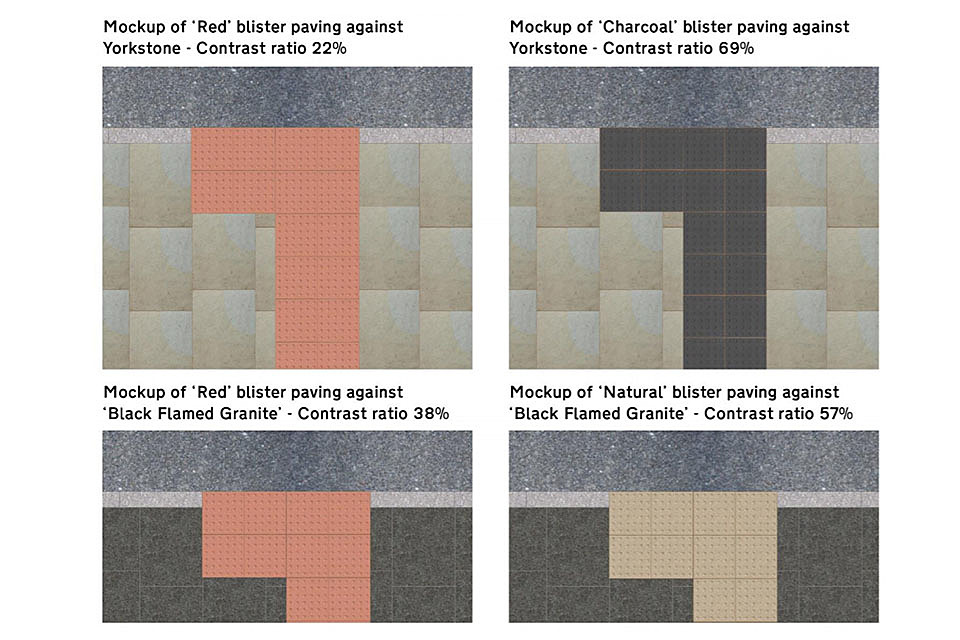
Figure 2.1
Figure 2.1: Images showing different combinations of colours of tactile paving and surrounding paving with their measured contrast ratios.
The figure displays four images of different coloured blister paving against different coloured surrounding paving, captions: Mockup of ‘Red’ blister paving against Yorkstone - Contrast ratio 22%, Mockup of ‘Charcoal’ blister paving against Yorkstone - Contrast ratio 69%, Mockup of ‘Red’ blister paving against Black Flamed Granite’ - Contrast ratio 38%, Mockup of ‘Natural’ blister paving against ‘Black Flamed Granite’ - Contrast ratio 57%.
Do you agree with this amendment to the tactile paving guidance?
If you do not agree what are your objections?
- Introduce a universal requirement for the boundary between carriageway and footway to be demarcated with tactile paving wherever they are at the same level
7.1 Replaces: “Where an extensive area of the carriageway has been raised then it will not be appropriate to install the tactile surface along the full length. In those circumstances the tactile surface should be limited to the ‘crossing’ area (Figure 15 page 49), and the remaining raised carriageway either side of the tactile surface should maintain a level difference with the footway of at least 25mm high or have a continuous physical barrier, for example, planters, railings” 1.5.5.1 (p48) […] “Where the carriageway has been raised to the level of the footway around an entire junction, it is essential that visually impaired pedestrians are kept away from the radius by the use of continuous physical barriers, for example, guard railings (Figure 17 page 50).” 1.5.5.3 (p48)
7.2 With: Wherever there is no level change between carriageway and footway, or a level change of less than 60mm, the boundary between footway and carriageway should be delineated with a tactile surface of at least 800mm in depth. This rule should apply to any continuous barrier-free surface occupied by pedestrians and vehicles be that a flat top road hump, a raised side road or junction, or an extended level surface area.
7.3 Justification: Workshop participants agreed that there needed to be a simple, unambiguous rule to prevent the appearance of un-delineated level surfaces (for example where designers implemented the raised junction treatment described but omitted the guard railings). Research has indicated that 60mm is the minimum level change that can be reliably detected by people with sight impairments in the absence of tactile paving whilst 800mm is the minimum depth of tactile paving that can be reliably detected.
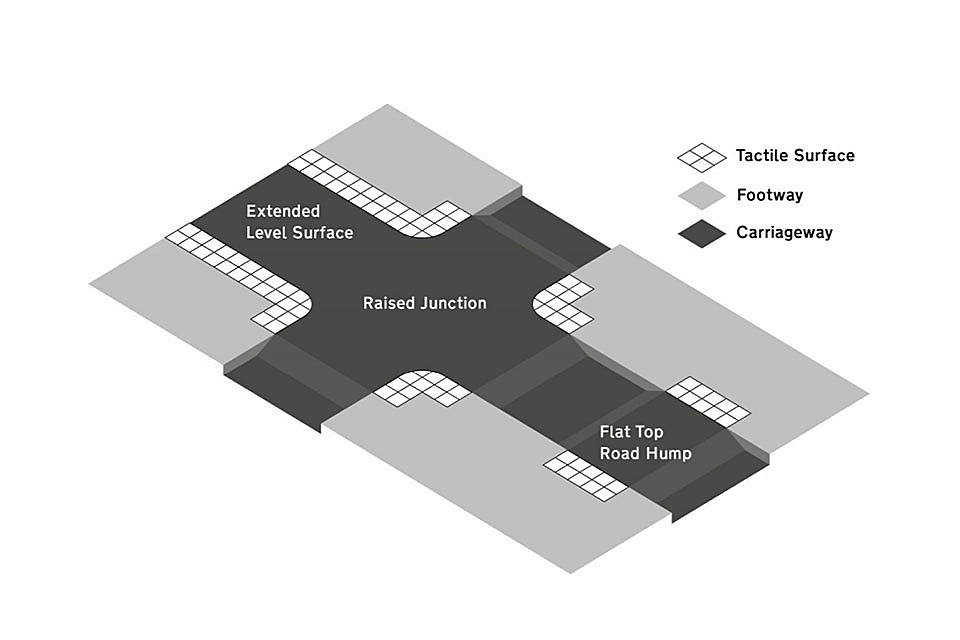
Figure 3.1
Figure 3.1: Proposed deployment of tactile surface(s) in level surface contexts
The figure displays a flat top raised hump (traffic table), a raised junction and an extended level surface area all with tactile paving demarcating the boundary between footway and carriageway wherever they are at the same level.
Do you agree with this amendment to the tactile paving guidance?
If you do not agree what are your objections?
- Suggestions for crossing improvements 8.1 The following two points do not replace any section of the ‘Guidance on the use of tactile paving surfaces’ but are suggestions that workshop participants feel would also improve the tactile environment.
(I) Push-button boxes at both sides of controlled crossings to have tactile rotating cones
8.2 In many local authorities it is standard practice to only install tactile rotating cones at right-hand push-button boxes even when boxes are installed on both sides of a controlled crossing. Workshop participants felt that boxes on both sides would make busy crossings easier to use for people with sight impairments, particularly long cane users.
(II) Push-button boxes at controlled crossings to carry tactile arrows indicating the direction of crossing
8.3 Workshop participants felt that tactile arrows on push-button boxes (as deployed in Israel) could present a more effective way of indicating crossing direction than the back edge of an area of tactile paving.
8.4 It was felt that the addition of these arrows could compensate for any navigational information lost as a result of implementing Amendment 1 whilst providing additional information to those not able to orientate themselves using the blister alignment.
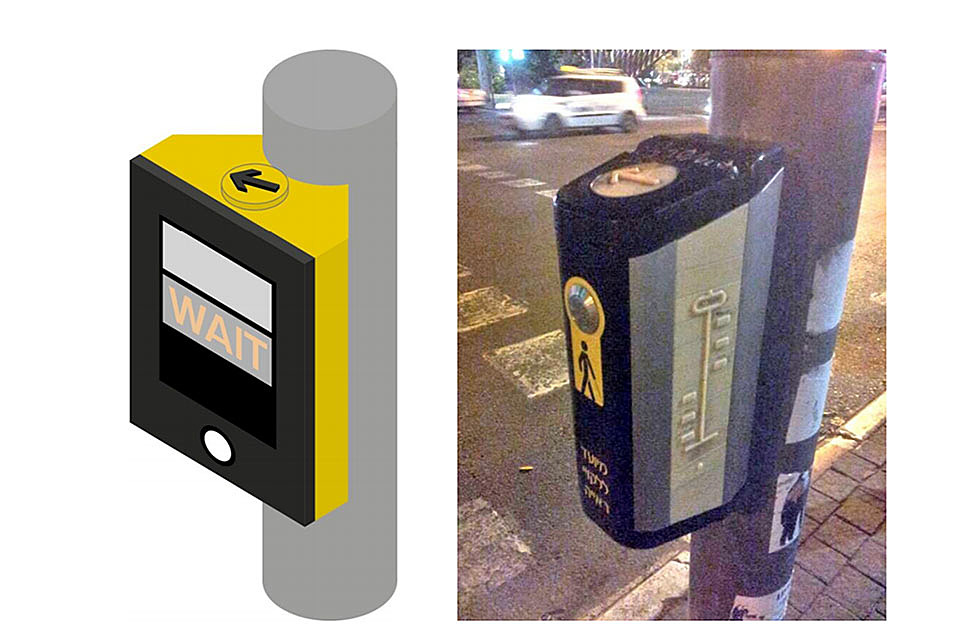
Figure 4.1
Figure 4.1: Illustration of tactile arrow on UK push-button box
The figure shows an illustration of a UK yellow push-button box with a black tactile arrow on a yellow disc, positioned on the top in the centre pointing in the crossing direction. On the right is a photograph of a push-button box with a white tactile arrow on the top and a tactile map on the side depicting the number of lanes to be crossed and their direction. The box has script in hebrew on the front.
Do you agree that where signal controlled crossings have two push button boxes they should both have tactile rotating cones?
Do you agree that push button boxes at signal-controlled crossings should have tactile arrows indicating the crossing direction?
If you do not agree with either of the above what are your objections?
What will happen next
9.1 A summary of responses, including the next steps, will be published within three months of the consultation closing on GOV.UK.
9.2 Alternative format copies will be available on request.
9.3 If you have any questions about this consultation please contact tactile.paving@dft.gsi.gov.uk
Annex A: Full list of consultation questions
Question 1
Relaxation of the requirement for the back edge of an area of blister paving to be perpendicular to the crossing direction: * Do you agree with this amendment to the tactile paving guidance? * If you do not agree what are your objections?
Question 2
Replacement of the requirement for blister paving at a controlled crossing to be red with a requirement for at least a 50% contrast ratio with the surrounding paving: * Do you agree with this amendment to the tactile paving guidance? * If you do not agree what are your objections?
Question 3
Introduce a universal requirement for the boundary between carriageway and footway to be demarcated with tactile paving wherever they are at the same level:
- do you agree with this amendment to the tactile paving guidance?
- if you do not agree what are your objections?
Question 4
Suggestions for crossing improvements:
- do you agree that where signal controlled crossings have two push button boxes they should both have tactile rotating cones?
- do you agree that push button boxes at signal-controlled crossings should have tactile arrows indicating the crossing direction?
- if you do not agree with either of the above what are your objections?
Annex B: Consultation principles
The consultation is being conducted in line with the Government’s key consultation principles.
